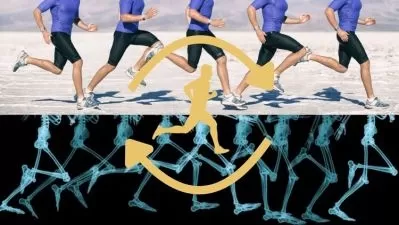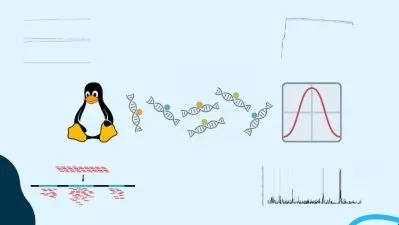Biomechanics: The Physics Of Human Movement
Emil Cordes
3:29:32
Description
Understand The Science Behind Movement: Apply Mechanical Principles To The Musculoskeletal System Of The Human Body
What You'll Learn?
- Understand the effect of physics on our movements and our body
- Become familiar with the basics of mechanics
- Get to know different tools on how to analyze and optimize motion
- Understand how our muscle types influence the amount of force that can be generated
- Learn how forces interact in static and dynamic systems and its effect on bodies
- Get to know the anatomy and the function of the skeletal system and the muscular system
- Learn how our bones deform in response to movements and loads
- Understand the meaning of biomechanics and possible fields of work
Who is this for?
What You Need to Know?
More details
DescriptionGET TO KNOW THE BIOMECHANICS OF THE HUMAN BODY BY COMBINING THE PHYSICS WITH THE ANATOMY!
In this course, we apply mechanical principles to the musculoskeletal system in order to understand, analyze and optimize human movement.
In other words, we combine the human anatomy with the mechanics, forming the interdisciplinary science called biomechanics. So whether you are a doctor, a trainer or an athlete and know the human body or you are an engineer or a physicist and know the mechanics, this course is going to help you understand the other side of the puzzle.
If You Are Curious And Want To Pursue A Career In Biomechanics, Check Out This Course.
As a studied biomechanist myself, I study the science of human locomotion and find ways to analyze and optimize movements. This course contains lots of valuable scientifically proven knowledge that I have gained over the years studying and working in the field of biomechanics, put together into 60+ lectures and 3.5 hours of content. Let me share it with you!
I will take you through all the important matters related to the biomechanics, from the principles of mechanics (statics, elastostatics, kinematics & kinetics), all the way to the structure and functioning of the musculoskeletal system. Throughout this course, we will talk about practical examples, so you'll get a better idea of possible applications for biomechanics in the industry.
After finishing this course, you will be able to:
Understand the basics of the mechanics as well as the anatomy
Know possible fields of work for biomechanics
Understand how forces act in static and dynamic systems
Understand how bodies deform under stress and strain
Understand how the human body is built mechanically
Know the most common tools used for motion analysis in the industry
The following topics will be covered in this course:
Definition
How can we define the term biomechanics?
What are the tasks of biomechanics and which fields of work are there?
What are some practical examples for biomechanical problems?
Basics Of Physics: Mechanics
What do we need to know about the mechanics?
How can we physically define parameters like the velocity, the force or the energy?
What are the mathematical formulas to calculate those parameters?
Statics Of The Human Body
What are Newton's laws are why are they important to understand?
How can we calculate forces and moments in static systems?
What and where is the center of gravity of a body?
The Skeletal System
What's the structure of bones and joints?
What does "stress shielding" mean and why is it bad?
How is the knee joint built and what's the biomechanical role of the patella?
Stability & Resistance Of The Human Body
Which types of loading and deformation are there?
How can we define and calculate internal forces?
How can we calculate the stress and the strain within objects?
The Muscular System
What's the structure and function of tendons and ligaments?
Which types of muscle are there and how are they built?
How do muscles contract and how does it affect force generation?
Kinematics & Kinetics Of Human Movement
What's the difference between kinematics and kinetics?
How can we describe moving bodies?
How can we calculate forces in dynamic systems?
Motion Analysis: Tools & Strategies
What are the objectives of motion tracking?
Which tools for the analysis of human movement exist in the industry?
How can we further analyze data obtained from motion tracking systems?
Of course, there is a 30-day money-back guarantee from Udemy. Feel free to enroll now to see if this course is for you!
Who this course is for:
- Engineers who are looking to understand the anatomy of the human body better
- Athletes, coaches and trainers who are looking to understand the mechanics of human movement better
- Anybody who is interested in learning about how we move
GET TO KNOW THE BIOMECHANICS OF THE HUMAN BODY BY COMBINING THE PHYSICS WITH THE ANATOMY!
In this course, we apply mechanical principles to the musculoskeletal system in order to understand, analyze and optimize human movement.
In other words, we combine the human anatomy with the mechanics, forming the interdisciplinary science called biomechanics. So whether you are a doctor, a trainer or an athlete and know the human body or you are an engineer or a physicist and know the mechanics, this course is going to help you understand the other side of the puzzle.
If You Are Curious And Want To Pursue A Career In Biomechanics, Check Out This Course.
As a studied biomechanist myself, I study the science of human locomotion and find ways to analyze and optimize movements. This course contains lots of valuable scientifically proven knowledge that I have gained over the years studying and working in the field of biomechanics, put together into 60+ lectures and 3.5 hours of content. Let me share it with you!
I will take you through all the important matters related to the biomechanics, from the principles of mechanics (statics, elastostatics, kinematics & kinetics), all the way to the structure and functioning of the musculoskeletal system. Throughout this course, we will talk about practical examples, so you'll get a better idea of possible applications for biomechanics in the industry.
After finishing this course, you will be able to:
Understand the basics of the mechanics as well as the anatomy
Know possible fields of work for biomechanics
Understand how forces act in static and dynamic systems
Understand how bodies deform under stress and strain
Understand how the human body is built mechanically
Know the most common tools used for motion analysis in the industry
The following topics will be covered in this course:
Definition
How can we define the term biomechanics?
What are the tasks of biomechanics and which fields of work are there?
What are some practical examples for biomechanical problems?
Basics Of Physics: Mechanics
What do we need to know about the mechanics?
How can we physically define parameters like the velocity, the force or the energy?
What are the mathematical formulas to calculate those parameters?
Statics Of The Human Body
What are Newton's laws are why are they important to understand?
How can we calculate forces and moments in static systems?
What and where is the center of gravity of a body?
The Skeletal System
What's the structure of bones and joints?
What does "stress shielding" mean and why is it bad?
How is the knee joint built and what's the biomechanical role of the patella?
Stability & Resistance Of The Human Body
Which types of loading and deformation are there?
How can we define and calculate internal forces?
How can we calculate the stress and the strain within objects?
The Muscular System
What's the structure and function of tendons and ligaments?
Which types of muscle are there and how are they built?
How do muscles contract and how does it affect force generation?
Kinematics & Kinetics Of Human Movement
What's the difference between kinematics and kinetics?
How can we describe moving bodies?
How can we calculate forces in dynamic systems?
Motion Analysis: Tools & Strategies
What are the objectives of motion tracking?
Which tools for the analysis of human movement exist in the industry?
How can we further analyze data obtained from motion tracking systems?
Of course, there is a 30-day money-back guarantee from Udemy. Feel free to enroll now to see if this course is for you!
Who this course is for:
- Engineers who are looking to understand the anatomy of the human body better
- Athletes, coaches and trainers who are looking to understand the mechanics of human movement better
- Anybody who is interested in learning about how we move
User Reviews
Rating
Emil Cordes
Instructor's Courses
Udemy
View courses Udemy- language english
- Training sessions 60
- duration 3:29:32
- Release Date 2024/05/14














